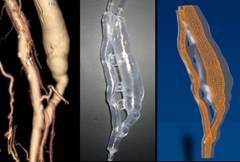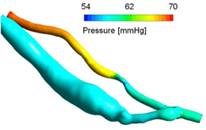Physiological flows
Anne-Virginie Salsac, Isabelle Claude, Dominique Barthès-Biesel
Cardiovascular diseases represent one of the leading causes of death in industrial countries.
They are associated with modifications of the geometry and mechanical
properties of vessels (stenosis, thrombosis, aneurism). Alterations of blood circulation at the
microscopic and macroscopic levels are observed in the case of degenerative
diseases whether they are cardiovascular or in certain cancers. In clinics,
classical investigation methods essentially rely on the determination of geometrical
criteria, or on the estimation of velocities through echo Doppler. We
contribute to the development of other non-invasive methods to diagnose lesions
at risk and provide a prognostic on the validity of treatment strategies
(bypass, endoprostheses).
However, our main action target is the study and development of minimally invasive
therapeutic techniques (embolization, cardiac valve repair, etc). On the fundamental aspect,
it necessitates quantifying the local
blood flow conditions and the impacts of medical devices on them. We study
these multiphysics phenomena and evaluate the
mechanical stresses generated by the blood flow on/in the arterial wall by
coupling in vitro and in silico modeling
approaches based on clinical data obtained via various imaging techniques (echography, MRI, …) (Figure 1).

 b
b 

Figure 1: a Patient-specific in vitro/in silico modeling of hemodynamics. b Endovascular treatments (in vitro/in silico models, preclinical studies)
Project
- Characterization of blood flows and vessel wall properties by coupling with medical imaging : Anne-Virginie Salsac, Isabelle Claude
- Study of therapeutic treatments: embolization, cardiac valve repair, angioplasty, stenting: Anne-Virginie Salsac, Dominique Barthès-Biesel